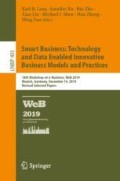Abstract
The online shopping platform, known as a two-sided market with buyers and sellers, always sponsor a Shopping Festival, such as Amazon “Black Friday”, Taobao “Double 11”. In this paper, a Stackelberg game model is constructed to study the platform discount deciding, seller pricing and advertising investment in the Shopping Festival. The research results show that (1) the optimal discount of the platform is related to the product buyer utility and unit cost. The higher the buyer utility of the product is, the larger the optimal discount coefficient of the platform is. The higher the unit cost of the product is, the larger the optimal discount coefficient for the platform is. (2) The platform profit increases in the number of buyers and the buyer utility of the product, and the profit increases in the platform transaction rate and the advertising cost coefficient firstly and then remains unchanged. (3) When the discount is more, seller’s optimal pricing remains unchanged, and the advertising investment level reduce with the decrease of the platform discount coefficient. When discount is less, seller’s optimal product pricing decreases in the decrease of the discount coefficient, but the advertising investment level remains unchanged.
Access this chapter
Tax calculation will be finalised at checkout
Purchases are for personal use only
References
Weisstein, F.L., Monroe, K.B., Kukarkinney, M.: Effects of price framing on consumers’ perceptions of online dynamic pricing practices. J. Acad. Mark. Sci. 41(5), 501–514 (2013). https://doi.org/10.1007/s11747-013-0330-0
Rochet, J., Tirole, J.: Platform competition in two-sided markets. J. Eur. Econ. Assoc. 1(4), 990–1029 (2003). https://doi.org/10.1162/154247603322493212
Armstrong, M., Wright, J.: Two-sided markets, competitive bottlenecks and exclusive contracts. Econ. Theory 32(2), 353–380 (2007). https://doi.org/10.1007/s00199-006-0114-6
Rochet, J., Tirole, J.: Two-sided markets: a progress report. RAND J. Econ. 37(3), 645–667 (2006). https://doi.org/10.1111/j.1756-2171.2006.tb00036.x
Belleflamme, P., Peitz, M.: Platform competition and seller investment incentives. Eur. Econ. Rev. 54(8), 1059–1076 (2010). https://doi.org/10.1016/j.euroecorev.2010.03.001
Reisinger, M.: Platform competition for advertisers and users in media markets. Int. J. Ind. Organ. 30(2), 243–252 (2012). https://doi.org/10.2139/ssrn.1855287
Hagiu, A.: Two-sided platforms: Pricing and social efficiency. J. Econ. Manag. Strategy 18(4), 1011–1043 (2009). https://doi.org/10.2139/ssrn.621461
Cao, K., He, P.: The competition between B2C platform and third-party seller considering sales effort. Kybernetes 45(7), 1084–1108 (2016). https://doi.org/10.1108/K-01-2016-0009
Bagwell, K.: The economic analysis of advertising. Handb. Ind. Organ. 3(06), 1701–1844 (2007). https://doi.org/10.7916/D8QZ2P6X
Butters, G.R.: Equilibrium distribution of sales and advertising prices. Rev. Econ. Stud. 44(3), 465–491 (1977). https://doi.org/10.2307/2296902
Acknowledgements
This research was supported by the National Natural Science Foundation of China under Grants 71771122.
Author information
Authors and Affiliations
Corresponding author
Editor information
Editors and Affiliations
Rights and permissions
Copyright information
© 2020 Springer Nature Switzerland AG
About this paper
Cite this paper
Zhang, H., Li, L., He, X., Zhu, X. (2020). Platform Discount Deciding, Seller Pricing and Advertising Investment in the Shopping Festival Based on Two-Sided Market Theory. In: Lang, K.R., et al. Smart Business: Technology and Data Enabled Innovative Business Models and Practices. WeB 2019. Lecture Notes in Business Information Processing, vol 403. Springer, Cham. https://doi.org/10.1007/978-3-030-67781-7_10
Download citation
DOI: https://doi.org/10.1007/978-3-030-67781-7_10
Published:
Publisher Name: Springer, Cham
Print ISBN: 978-3-030-67780-0
Online ISBN: 978-3-030-67781-7
eBook Packages: Computer ScienceComputer Science (R0)

